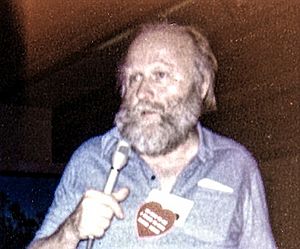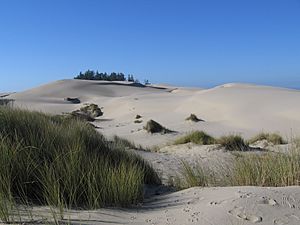Frank Herbert facts for kids
Quick facts for kids
Frank Herbert
|
|
|---|---|

Herbert in 1978
|
|
| Born | Franklin Patrick Herbert Jr. October 8, 1920 Tacoma, Washington, U.S. |
| Died | February 11, 1986 (aged 65) Madison, Wisconsin, U.S. |
| Occupation | Novelist |
| Alma mater | University of Washington (no degree) |
| Period | 1945–1986 |
| Genre | Science fiction |
| Literary movement | New Wave |
| Spouse |
|
| Children | 3; including Brian |
| Signature | |
Frank Herbert (born October 8, 1920 – died February 11, 1986) was an American science fiction writer. He is most famous for his 1965 novel Dune and its five sequels.
Even though he became well-known for his novels, he also wrote short stories. He worked as a newspaper journalist, photographer, and book reviewer. He also advised on environmental topics and gave lectures.
The Dune series takes place far in the future. It explores big ideas like how humans survive over long periods. It also looks at human evolution, planetary science (studying planets), and ecology (how living things interact with their environment). The series also shows how religion, politics, money, and power connect. This all happens in a future where people can travel between stars and have settled thousands of planets.
Dune is the best-selling science fiction novel ever. The whole series is seen as a classic in the genre (a type of literature).
Contents
Biography of Frank Herbert
Early Life and Career
Frank Patrick Herbert Jr. was born on October 8, 1920, in Tacoma, Washington. He grew up in the countryside. He loved books and could read much of the newspaper before he was five. He had a great memory and learned things quickly.
He was interested in photography from a young age. He bought his first camera at ten. Because his family was poor during the Great Depression, he left home in 1938. He went to live with his aunt and uncle in Salem, Oregon. He finished high school there in 1939.
In 1939, he got his first newspaper job by saying he was older than he was. He then worked for the Oregon Statesman newspaper. He did many jobs there, including being a photographer.
Herbert married Flora Lillian Parkinson in 1941. They had one daughter, Penelope. They divorced in 1943. During World War II, he served in the Navy for six months as a photographer. He left the Navy after an accidental head injury. Later, he worked for The Oregon Journal in Portland, Oregon.
After the war, Herbert went to the University of Washington. There, he met Beverly Ann Stuart in a writing class in 1946. They were the only students who had sold their writing. They got married in Seattle in 1946. They had two sons, Brian and Bruce.
In 1949, Herbert and his wife moved to California. They worked on the Santa Rosa Press-Democrat newspaper. There, they became friends with psychologists Ralph and Irene Slattery. The Slatterys introduced Herbert to ideas from thinkers like Sigmund Freud and Carl Jung. They also taught him about Zen Buddhism.
Frank Herbert never finished university. His son Brian said he only wanted to study what interested him. He went back to journalism. He worked for the Seattle Star and the Oregon Statesman. He was also a writer and editor for California Living magazine for ten years.
In 1973, Herbert said he had been reading science fiction for about ten years before he started writing it. He liked authors such as H. G. Wells and Robert A. Heinlein.
Herbert's first science fiction story was "Looking for Something." It was published in 1952. His first novel, The Dragon in the Sea, came out in 1955. This story was about sanity and madness on a submarine in the future. It also predicted conflicts over oil. It was praised by critics but did not sell many copies.
Creating Dune

Herbert started researching Dune in 1959. His wife, Beverly, went back to work full-time. This allowed him to focus completely on his writing. The novel Dune was published in 1965. This book started the whole Dune series.
He later explained that the idea for Dune came from a magazine article he was supposed to write. The article was about sand dunes in Oregon. He gathered so much information that it was too much for just an article. The article was never written, but it led to Dune.
Dune took six years to research and write. It was much longer than other science fiction books at the time. A magazine called Analog published it in two parts. But then, nearly twenty book publishers rejected it. One editor even wrote, "I might be making the mistake of the decade, but..."
Finally, a publisher known for auto-repair manuals, Chilton Book Company, decided to publish Dune. They offered Herbert money and future earnings. Herbert rewrote much of the book. Dune quickly became a success with critics. It won the Nebula Award in 1965 and the Hugo Award in 1966.
Dune was not an instant bestseller. By 1968, Herbert had earned $20,000 from it. This was a lot for a science fiction novel back then, but not enough for him to write full-time. However, publishing Dune opened new doors. He worked as an education writer for a newspaper. He also taught at the University of Washington. In 1972, he worked as an environmental advisor in Vietnam and Pakistan.
By the end of 1972, Herbert stopped working for newspapers. He became a full-time fiction writer. In the 1970s and 1980s, he became very successful. He split his time between homes in Hawaii and Washington. His home in Port Townsend was meant to be an "ecological demonstration project."
During this time, he wrote many books. He also shared his ideas about ecology and philosophy. He continued the Dune series with five more novels. He planned to write a seventh book to finish the series, but he passed away in 1986. This left some storylines unfinished.
Other books by Herbert include The Godmakers (1972) and The White Plague (1982). He also wrote books with Bill Ransom.
Later Life and Passing
Herbert's success came with sadness. In 1974, his wife Beverly had surgery for cancer. She lived for ten more years, but her health was affected. Beverly Herbert passed away on February 7, 1984. Herbert finished and published Heretics of Dune that same year. In his next book, Chapterhouse: Dune, he dedicated it to Beverly.
The year 1984 was difficult for Herbert. His wife died, but his career also grew with the release of David Lynch's film version of Dune. The movie had high hopes and a big budget. However, it received mostly bad reviews in the United States. But it was a success in Europe and Japan.
In 1985, after Beverly's death, Herbert married Theresa Shackleford. That same year, he published Chapterhouse: Dune. This book brought together many of the series' story threads. This was Herbert's last solo work. He passed away on February 11, 1986, in Madison, Wisconsin. He was 65 years old. He died from a serious blood clot while recovering from surgery for pancreatic cancer.
Views on Government
Herbert was a strong critic of the Soviet Union. He was a distant relative of the Republican senator Joseph McCarthy. Herbert was upset when McCarthy blacklisted people suspected of being communists. He believed this harmed important freedoms in the United States.
Herbert thought that governments sometimes lie to protect themselves. He believed that after the Watergate scandal, President Richard Nixon accidentally taught people an important lesson: not to trust government blindly. Herbert also did not support America's involvement in the Vietnam War.
Ideas and Themes in His Work
Frank Herbert used his science fiction novels to explore complex ideas. These included philosophy, religion, psychology, politics, and ecology. A main focus of his work was the question of human survival and evolution.
Herbert gained many devoted fans. Many tried to read everything he wrote, both fiction and non-fiction. They saw him as an expert on the topics in his books. Some readers were so devoted that Herbert was sometimes asked if he was starting a cult. He was very much against this idea.
Here are some key themes in Herbert's work:
- Leadership: He explored how humans tend to follow charismatic leaders. He looked at the good and bad sides of government and rules.
- Ecology and Systems Thinking: Herbert was one of the first science fiction writers to popularize ideas about ecology. He stressed that humans need to think about how things connect and plan for the long term.
- Religion, Politics, and Power: He examined how these three elements are linked.
- Human Survival and Evolution: Herbert wrote about groups like the Fremen and the Sardaukar. These groups were shaped by their harsh living conditions into strong, dangerous "super races."
- Human Potential: Herbert showed different ideas of what humans could become. Examples include the Mentats, the Bene Gesserit, and the Bene Tleilax.
- Sanity and Madness: Frank Herbert was interested in what makes someone sane or insane. He often asked, "What is sane?" He suggested that "normal" and "abnormal" are often relative terms.
- Language and Thought: He explored how language shapes the way we think.
- Learning and Thinking: Herbert also focused on how people learn and think.
Frank Herbert did not offer simple answers to the many questions he explored.
Impact on Science Fiction
Dune and the Dune series are among the world's best-selling science fiction books. Dune has received wide praise. It won the Nebula Award in 1965 and shared the Hugo Award in 1966. It is often considered one of the best science fiction novels ever. Readers of Locus magazine voted it the best science fiction novel of all time multiple times.
Dune is seen as a very important novel for several reasons:
- Soft Science Fiction: Dune is a key example of "soft science fiction." Herbert purposely limited technology in his Dune universe. This allowed him to focus on the future of humanity itself, rather than just future technology. Dune looks at how humans and their societies might change over time.
- Popularizing Scientific Ideas: Frank Herbert helped make scientific ideas popular. Many fans say he introduced them to philosophy and psychology. In Dune, he helped popularize the word ecology. A reviewer from The New York Times Book Review said that Herbert worked out the connections between people, animals, geography, and climate so well that Dune became the standard for "ecological" science fiction.
- World-Building: Dune is an amazing example of creating a detailed fictional world. The Library Journal said that "Dune is to science fiction what The Lord of the Rings is to fantasy." Herbert imagined every part of his creation. He included glossaries, quotes, and histories to make his universe feel real to readers. No science fiction novel before it had brought another world to life so vividly.
Herbert never again received as much critical praise as he did for Dune. None of his Dune sequels or other books won a Hugo or Nebula Award. However, almost all of them became New York Times Best Sellers.
The Science Fiction Hall of Fame welcomed Herbert in 2006.
California State University, Fullerton's library has some of Herbert's early writings for Dune and other works. These include his notes.
Metro Parks Tacoma built Dune Peninsula and the Frank Herbert Trail in Point Defiance Park in July 2019. This was to honor the writer from their hometown.
Images for kids
See also
 In Spanish: Frank Herbert para niños
In Spanish: Frank Herbert para niños


